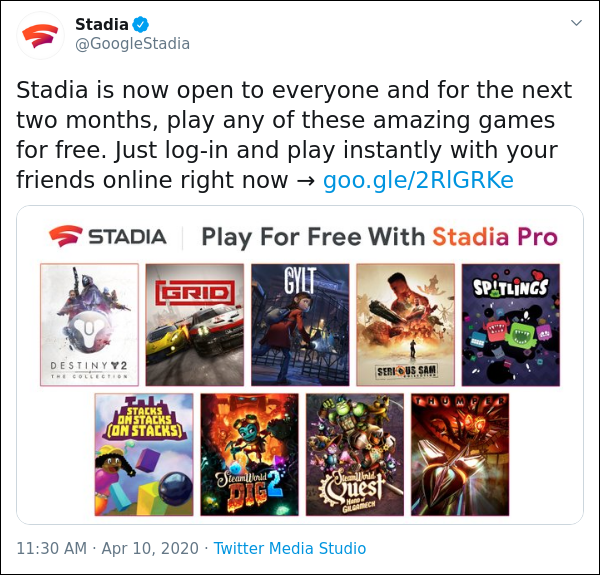Do you enjoy playing games on your Fedora system? You might be interested to know that Stadia is available to play via a Google Chrome browser on your Fedora desktop. Additionally, Stadia is free for two months starting April 8th. Follow these simple steps to install the Google Chrome web browser in Fedora and enjoy the new world of cloud-based gaming on your Fedora Linux PC!
- Go to https://www.google.com/chrome using any available web browser and click the big blue button labeled Download Chrome.
- Select the 64 bit .rpm (For Fedora/openSUSE) package format and then click Accept and Install.
- You should be presented with a prompt asking what you want to do with the file. Choose the Open with Software Install option if you see this prompt.
- Click Install in the Software Install application to install Google Chrome. You may be prompted for your password to authorize the installation.
If you don’t see the Open with Software Install option at step 3, choose to save the installer to your Downloads folder instead. Once you have the installer downloaded, enter the following command in a terminal using sudo:
$ sudo dnf install ~/Downloads/google-chrome-*.rpm
Once you have Google Chrome installed, use it to browse to https://stadia.google.com/ and follow the directions there to create your user profile and try out the games.
Chrome installation demonstration
Additional resources

Photo by Derek Story on Unsplash.






Artem
Not available for many countries unfortunately.
vic
Fedora is for programmers. Easy to setup cloud proxy in any useful locale.
Rowan
Anyone can use Fedora.
It’s not just for developers.
Squifi
Great News,
I have been using the Stadia App provided by Google for a few days now and it works amazingly if using the Gnome for Xorg option during login.
The hardware acceleration does not seem to work under wayland for the google chrome, meaning that you would have to dial down the resolution due to the processor doing all the processing of the stream information that is sent.
Great feature nontheless, have had fun playing Destiny and just bought the Division 2. Absolutely amazed how well it works.
Cheers for article, Greg.
All the best,
Squifi
Richard
For me it works fine with Wayland and Chromium (using the vaapi-patched chromium-freeworld from rpmfusion). On wayland it’s important to set the correct LIBVA_DRIVER_NAME – in my case (Ryzen 3700U Laptop) the full startup cmd is:
LIBVA_DRIVER_NAME=radeonsi /usr/bin/chromium-freeworld –ignore-gpu-blacklist –enable-gpu-rasterization –enable-native-gpu-memory-buffers –enable-zero-copy
You can use the Chromium stadia app which will place a desktop file within your home at ~/.local/share/applications/chrome-…-Default.desktop – you can modify it and add the correct parameters there. To be sure what to add for the LIBVA_DRIVER_NAME env variable, have a look here https://wiki.archlinux.org/index.php/Hardware_video_acceleration#Configuring_VA-API
xvitaly
Advertisement of third-party proprietary service and proprietary browser? No way!
Gregory Bartholomew
It’s an understandable response. I debated posting this article, but Google has done a lot to advance Linux. It is because of Google that there are several billion devices running the Linux kernel today. So I think we can cut them a little slack. Also, the price is right. I read somewhere that they plan to make Stadia free permanently at some point.
Cassie
No,we cannot cut them any slack. They have a vast history of abusing peoples privacy. Anyone who supports foss knows that respecting user choice is essential.
Michal Konečný
If you know about free software alternative of Stadia, I would be glad to read about it.
It’s not about purposeful advertisement, there is just no alternative to this you can write about.
Kamil
We have Chromium in Fedora repositories. I expected the article to mention it and either recommend it instead of Chrome, or say that it doesn’t work there. But Chromium is not mentioned at all, which feels weird to me.
Gregory Bartholomew
Sorry about that. I read that Chromium doesn’t work and I didn’t even try it.
Liam Dawe
Chromium does work, as I wrote about on GamingOnLinux: https://www.gamingonlinux.com/articles/some-early-first-impressions-of-google-stadia-played-on-linux.15466 – you can see shots of it using Chromium quite clearly in there. The video included was also showing Chromium.
AsciiWolf
Why not use Chrome from the official Fedora third-party repositories?
Gregory Bartholomew
If you mean Chromium, Stadia doesn’t work with Chromium.
AsciiWolf
No, I meant Chrome. It is a part of the official third-party repositories set. See this article: https://fedoramagazine.org/third-party-repositories-fedora/
Travis Juntara
There are some further optimizations to be had for lower end computers.
For instance, on Linux stadia seems to prefer streaming to you over VP9 regardless (likely due to lack of video acceleration support). But if you use a hardware-accelerated video decode version of Chromium such as chromium-freeworld (rpmfusion), You can download the “Stadia+” Chrome extension, and force H264 video decoding, which should reduce CPU utilization (75% => 60% on my Intel Core i5-4310M) and smooth out stuttering and dropped frames, at the cost of some increased bandwidth.
I followed this guide here: https://www.allstadiagames.com/threads/fix-stadias-lag-and-stutter-on-fedora-linux-with-intel-graphics.8167/
Gregory Bartholomew
Thanks Travis! I wish I could promote your helpful comment somehow to make it more visible.
Peter
How about editing the article. Using chromium-freeworld and the stadia extension seems to make a lot of sense.
Let’s give this a try quickly before Stadia is going to disappear again…
Gregory Bartholomew
It should probably just be a whole new article. Although I have access to “edit” my own article, the last time I tried that, my article unpublished and I discovered that I don’t have access to publish articles to the magazine. The magazine has a review board that likes to at least skim the content that gets published to make sure there are no copyright issues or anything.
Also, I’m not sure that chromium-freeworld is the right solution for everyone. If your computer is fast enough and your hardware is supported, you might get better results with the official/production version of their browser.
Google is constantly revising their official Chrome browser. Even if chromium-freeworld works better right now for a given hardware configuration, that situation could change quite quickly.
If someone wants to do a detailed how-to for the chromium-freeworld solution, go for it! The process for submitting article ideas and writing them up if they get approved is documented in detail here: https://docs.fedoraproject.org/en-US/fedora-magazine/workflow/
Maciej
This comment is much more useful than entire post that should be titled “How to install Google Chrome on Fedora”.
Gregory Bartholomew
It looks like Chrome does in fact support hardware-accelerated video decoding under Linux. From an inexpensive PC I picked up recently from BestBuy:
[/opt/google/chrome]$ sudo dmidecode | grep -A 4 “^BIOS I”
BIOS Information
Vendor: LENOVO
Version: O2HKT61A
Release Date: 06/17/2019
Address: 0xF0000
[/opt/google/chrome]$ lspci | grep VGA
00:01.0 VGA compatible controller: Advanced Micro Devices, Inc. [AMD/ATI] Stoney [Radeon R2/R3/R4/R5 Graphics] (rev da)
[/opt/google/chrome]$ modinfo amdgpu | grep -v “^parm|^sig|^ver|^alias|^firmware|^ ”
filename: /lib/modules/5.5.17-200.fc31.x86_64/kernel/drivers/gpu/drm/amd/amdgpu/amdgpu.ko.xz
license: GPL and additional rights
description: AMD GPU
author: AMD linux driver team
depends: drm_kms_helper,drm,gpu-sched,ttm,amd_iommu_v2,i2c-algo-bit
retpoline: Y
intree: Y
name: amdgpu
[/opt/google/chrome]$ ./chrome –ignore-gpu-blacklist –enable-vaapi
And then browsing to chrome://gpu I see:
Graphics Feature Status
* Canvas: Hardware accelerated
* Flash: Hardware accelerated
* Flash Stage3D: Hardware accelerated
* Flash Stage3D Baseline profile: Hardware accelerated
* Compositing: Hardware accelerated
* Multiple Raster Threads: Disabled
* Out-of-process Rasterization: Disabled
* OpenGL: Enabled
* Hardware Protected Video Decode: Hardware accelerated
* Rasterization: Software only. Hardware acceleration disabled
* Skia Renderer: Enabled
* Video Decode: Hardware accelerated
* Vulkan: Disabled
* WebGL: Hardware accelerated
* WebGL2: Hardware accelerated
P.S. The gameplay was terrible just now when I tried it on this PC. I’m not sure if it was my internet connection or because the computer is just too low-end.
Travis Juntara
I wasn’t able to reproduce enabling VAAPI on Google Chrome,
but something I did notice though in regards to Intel vs. AMD GPUs
was that when I switch from Intel HD 4600 to my AMD Radeon HD 8790M (amdgpu experimental on MESA 19.2.8) using DRI_PRIME=1 env var to run chromium-freeworld for Stadia (H264, video acceleration on), there’s this huge intermittent input lag on the AMD Radeon that makes games unplayable, even though readings on the Network monitor in Stadia+ indicates everything’s fine.
Gregory Bartholomew
That sounds a lot like what I was just experiencing with VAAPI on Google Chrome. So maybe it wasn’t (just) my internet connection.
So, FYI to people who may be wanting to try this — Stadia is still pretty beta right now and YMMV depending on hardware and other factors.
I think the internet in general may be under a somewhat excess load right now owing to other factors as well.
Still, I think it is kind of cool that they are pushing the envelope on this.
Andrew
@Gregory I don’t have a problem with you promoting Chrome but for the record Chrome doesn’t have have hardware accelerated video decoding under Linux, they have publicly stated that regardless of what it says under chrome://gpu it’s been completely disabled due to the “lack of quality video drivers.” You can confirm this by just looking at your CPU usage.
Gregory Bartholomew
Well, it certainly doesn’t work with my driver and hardware, but it definitely isn’t just a dummy value either. The effects of passing
to the official chrome for linux are very noticeable. And from what Travis reported, the effect seems to be exactly the same as trying to run chromium+vaapi+amdgpu. At least for the moment anyway. Sometimes what is said/reported is out-of-sync with conditions on the ground.
If people want to use chromium, that’s perfectly fine too. If people don’t want to go through that effort though, they may not have to.
Andrew
Like your current setup mine does not have any effect. I’ve tried on a handful of computers , 5 or so at least , have you ever seen an obvious drop in CPU usage first hand?
Gregory Bartholomew
I have not seen a positive effect first-hand. But according to Travis’ comment earlier, even the full chromium+vaapi setup only showed a change in CPU usage from “75% => 60%”. So I’m not sure that it would be “obvious” in any case. Someone with a working setup would need to do a side-by-side comparison to know for sure.
** Edit to note:
I just want to be careful not to over-sell the idea that if someone spends 20+ hours trying to get chromium with vaapi built it will magically make everything work perfectly. If people are sold that, and they go though all that trouble for naught, it can turn them off. The more typical user is probably better off just reporting the problem to Google and/or their hardware vendor and letting their engineers address the issue.
Keep in mind that things are constantly in flux. For example, look at all the changes that were just made to the amdgpu driver in the 5.6 kernel release:
https://kernelnewbies.org/Linux_5.6#Graphics
Unfortunately, I cannot test the latest amdgpu driver because my PC is also running ZFS which isn’t yet compatible with the 5.6 kernel.
Also, a senior engineer at Lenovo — Mark Pearson — just stated that Lenovo will be working extra hard to be sure that the nouveau driver will work properly “out of the box” on their hardware.
So if something doesn’t work right now, that could quite easily change with the next kernel version or chrome release. Don’t take “it doesn’t work” as “it will never work”. Let the engineers know about the problem and give it a little time. Things are changing fast.
Andrew
It’s probably true that I expect too much from GPU video decode, the only time I can remember seeing what I consider an obvious CPU decrease is with MPV and H264.
A couple articles out there refer to this in regards to Chromium/Chrome “never” getting GPU video decode support but it’s hardly definitive when you actually read it, things do change.
https://bugs.chromium.org/p/chromium/issues/detail?id=463440#c65
Andrew
Even old un-patched versions of Chromium will say it’s enabled in chrome://gpu if you “enable” it in settings and change the GPU flag.
glypo
I have enjoyed my delve back into Firefox after many years away, but I will admit, this may be a compelling reason to keep Chrome on my system. I love gaming, and I love Linux, two worlds that don’t easily reconcile. Though I use Steam on Fedora, which is great for the smaller releases (Kerbal, Factorio, more recently Table Top Simulator, etc) it is rubbish for the AAA titles, where I default to my PlayStation.
It has been frustrating to see the likes of PlayStation Now, GeForce Now and more come along offering streaming for virtually all devices and OSs other than Linux. Having run Fedora since its first release, after switching from Red Hat 9, I am not surprised at all that gaming natively on Linux hasn’t exploded, in fact I am pleased how good Steam is. However, I have been disappointed that the streaming efforts haven’t reached us until now, so I must commend Google and Stadia.